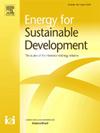Abandoning renewable energy projects in Europe and South America: An emerging consideration in the recycling of energy landscapes
IF 4.4
2区 工程技术
Q2 ENERGY & FUELS
引用次数: 0
Abstract
Landscape legacies of conventional energy development are vast. Mines, well fields, power plants, sub-stations, refineries, and disposal sites have been accumulating for more than a century. We know these energy landscapes exist, but we are uncertain what to do with them once their initial function is completed. Can they be used for any future purpose; that is, can they be “recycled”? As we gradually shift to renewable energy resources for all the benefits they promise, we are becoming aware that we will be facing similar end-of-life questions about the unique landscapes they are creating. What is their landscape legacy? This paper expands on growing attention to recycling conventional energy landscapes by introducing the circumstances regarding renewable energy landscapes. It addresses the first stages in consideration of these questions as they pertain to the abandonment of renewable energy infrastructures in Europe and South America. Based on reconstructive and comparative analysis of examples of abandoned wind farms, we found that there are barriers to formal decommissioning of these facilities, leaving recycling options as open questions. The main conclusion is that abandoned wind farms are consequences of gaps and weaknesses in the regulations on decommissioning of renewable energy infrastructures, in particular in case of installations abandoned before reaching their operational end-of-life. The need to improve those regulations will be crucial to ensure the restoration and recycling of renewable energy landscapes going forward.
放弃欧洲和南美的可再生能源项目:能源景观回收中的一个新考虑
传统能源开发的景观遗产是巨大的。矿井、井场、发电厂、分站、炼油厂和处理场已经积累了一个多世纪。我们知道这些能量景观的存在,但我们不确定一旦它们的初始功能完成后该如何处理它们。它们是否可以用于任何未来的目的;也就是说,它们能被“回收利用”吗?随着我们逐渐转向可再生能源,以获得它们所承诺的所有好处,我们开始意识到,我们将面临类似的关于它们所创造的独特景观的临终问题。他们的景观遗产是什么?本文通过介绍有关可再生能源景观的情况,扩展了对回收传统能源景观的日益关注。它解决了考虑这些问题的第一阶段,因为它们与欧洲和南美洲放弃可再生能源基础设施有关。基于对废弃风电场实例的重建和比较分析,我们发现这些设施的正式退役存在障碍,使回收选择成为悬而未决的问题。主要结论是,废弃的风力发电场是可再生能源基础设施退役法规存在漏洞和缺陷的结果,特别是在设备未达到运行寿命就被废弃的情况下。改善这些法规对于确保未来可再生能源景观的恢复和循环利用至关重要。
本文章由计算机程序翻译,如有差异,请以英文原文为准。
求助全文
约1分钟内获得全文
求助全文
来源期刊

Energy for Sustainable Development
ENERGY & FUELS-ENERGY & FUELS
CiteScore
8.10
自引率
9.10%
发文量
187
审稿时长
6-12 weeks
期刊介绍:
Published on behalf of the International Energy Initiative, Energy for Sustainable Development is the journal for decision makers, managers, consultants, policy makers, planners and researchers in both government and non-government organizations. It publishes original research and reviews about energy in developing countries, sustainable development, energy resources, technologies, policies and interactions.
 求助内容:
求助内容: 应助结果提醒方式:
应助结果提醒方式:


